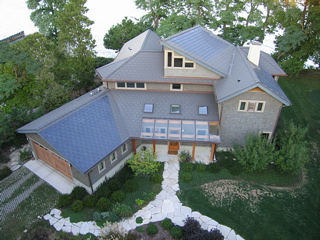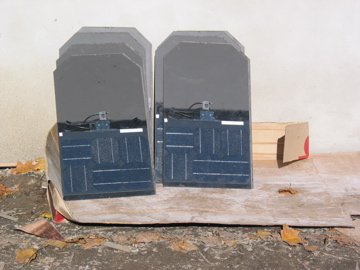
ELECTRICAL POWER
Roughly two-thirds of the 22,000 pounds of annual carbon emissions related to operating the average home is attributable to the electricity used in the home. One strategy for reducing these emissions is to select energy-efficient versions of appliances, lighting, and other products for the home. Another strategy is to adopt energy-saving routines and habits such as turning down the thermostat in winter and closing window shades against the sun's heat in summer. Design features--such as skylights and open floor plans to maximize natural daylighting--also play a key role.Reducing consumption is only part of the solution, however. Equally important is using non-polluting, renewable sources of energy for as much of the remaining power needs of the home as possible. For this house, a system of integrated photovoltic roofing slates (visible here on the garage roof) supplies 80 percent of the home's annual electrical consumption and demonstrates conclusively the feasibility of a PV system in the upper Midwest. (Another approach is to participate in one of the growing number of programs that allow consumers to buy green power.)
CONTENTS
|
Solar Power in the Upper Midwest
Many people are surprised at the notion that converting sunlight to electricity is practical in the upper Midwest. In fact, the Chicago area receives a "good" amount of solar energy, according to FindSolar, which estimates that an average of 4.466 kWh/sq meter/day of solar energy is available across the year here. Even on partly cloudy days, photovoltaic (PV) cells can produce up to 80 percent of their usual amount of energy, while on extremely overcast days, they still can produce about 30 percent. And during Chicago's famously hot and sunny summers, when air conditioners are turned up high and electricity is in heavy demand, a PV system can readily produce far more energy than the home uses. Not only does this help reduce the demand on the electric utility grid during peak load time, but the excess electricity generated by the PV system can also be fed into the grid.
Basic Photovoltaic Technology
PV systems produce direct current (DC) electricity. Since lights, electrical appliances, and other equipment in the U.S. are designed to use alternating current (AC) electricity, an inverter is needed to change the DC solar power into usable 120-volt AC electricity. Some systems may also include a battery storage system for emergency backup in the event of a power failure or in cases where the system is not connected to the electric utility grid. A charge controller is added to protect the batteries from over-charging or from being drained too much. Proper installation is key to maximizing the system's effectiveness. It's important, first of all, to select a location where the solar panels can receive unimpeded solar energy througout the day. Any shade from a nearby tree or building can reduce the efficiency of the entire system significantly. The orientation of the panels is another key consideration. Although a south-facing roof is generally considered ideal, a system as much as 20 degrees off due south can still be very successful. A third consideration is the angle at which panels are mounted. Again, there is an "ideal," with an angle equal to the latitude of the area deemed optimal to accommodate both high sun in summer and low sun in winter. In fact, a different angle (and/or a different orientation) may be desirable in order to maximize production more selectively--during hours of peak utility demand, for example.
Selling Surplus Power to the Electric Utility Grid
Under federal law, power providers must purchase any excess electricity generated by small renewable energy systems at a rate equal to what it would cost the utility to produce the power itself. In some states, this requirement is implemented through a net purchase and sale arrangement. Two uni-directional meters are installed, one that records the amount of electricity drawn from the grid and the other the excess electricity generated by the home/business and fed into the grid. The consumer pays retail rate for the electricity provided by the utility, and the power company pays wholesale rate (its avoided cost) for the surplus generated by the home/business. Many states have gone beyond this minimum requirement to allow net metering. With this arrangement, a single, bi-directional meter is used; the meter spins forward as electricity is drawn from the grid and backward as the solar electric system produces more power than is needed at that time. At the end of the billing period, if more electricity has been drawn from the grid than the solar system supplied to the grid, the consumer pays retail rate for the net energy consumed. If the system produced more electricity than was used, the utility either pays for the net amount generated, typically at its avoided cost, or provides a credit that can be used to offset charges in future months.
The PV System Installed at This House
The local utility company, Commonwealth Edison, installed a two-channel meter that separately measures the gross amount of electricity delivered by ComEd to the house and the amount of excess electricity generated by the PV system and fed back to the utility. Each month's bill reports the number of kilowatt-hours of electricity provided by ComEd and the number of PV-generated kilowatt-hours of electricity fed back to the grid. ComEd originally charged retail rate for the electricity it provided and paid wholesale rate for the surplus electricity supplied to it. In 2007, the company began offering a real time pricing option where the rate varies from hour to hour based on the actual market price of electricity each hour. Now with this program, the real time price is used to calculate the rate for both the electricity provided by ComEd and the electricity supplied by the home.
Performance
Links and Resources
|
Website prepared by Eleanor Revelle.
Last revised: February 2014
